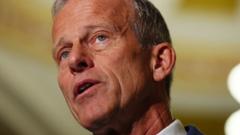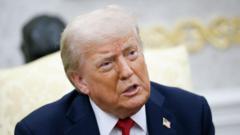India's GDP growth rate has plummeted to 5.4%, prompting discussions about underlying economic challenges and potential remedies.
**India's Economic Growth Faces Significant Challenges Amid Slumping GDP**

**India's Economic Growth Faces Significant Challenges Amid Slumping GDP**
As India's economy hits a seven-quarter low, experts debate what this means for its future.
India's economy has recently faced a sobering decline, with its GDP dropping to 5.4% between July and September—the lowest figure in seven quarters. This rate falls significantly short of the Reserve Bank of India's (RBI) forecast of 7%, signaling a potential slowdown in what has been touted as the world's fastest-growing large economy. Although the growth rate continues to outperform those of developed nations, the fall raises alarms among economists.
Several factors contribute to the slowdown. Weaker consumer demand, stagnant private investment, and reduced government spending—once a critical driver—have all played roles. The country’s export performance has also lagged, with its goods exports representing only 2% of global exports in 2023.
Multiple sectors are showing signs of struggle. Quick-moving consumer goods (FMCG) companies are experiencing modest sales, and salary expenses at publicly traded firms have decreased in the past quarter. The RBI has reassessed its growth projections for the fiscal year 2024-2025 to 6.6%. Rajeshwari Sengupta, an economist, notes that the decline has been an ongoing issue, indicating a systemic slowdown.
Finance Minister Nirmala Sitharaman offers a more optimistic viewpoint, arguing the slump is non-systemic and linked to a reduction in government spending during an election cycle. She anticipates an uptick in growth in the third quarter, asserting that India will likely remain the fastest-growing major economy despite factors such as stagnant wages and external demand challenges.
Yet inflation remains a concern, surging to 6.2% in October, primarily due to elevated food prices, which currently constitute half of the consumer price index. The central bank has not adjusted interest rates in nearly two years, aiming to combat rising inflation, while also facing criticism that these high rates might be hindering economic growth.
Economist Himanshu points out that merely reducing interest rates won't lead to increased growth without robust consumption demand. Meanwhile, Shaktikanta Das, the outgoing RBI governor, maintains that India's economic prospects remain favorable.
Analysts note a dichotomy in India's economy: the older economy, including the informal sector and traditional industries, is stagnant compared to the newer economy, which has thrived on services and outsourcing. Deloitte suggests that India is now home to over 50% of the world's global capability centers (GCCs), contributing robustly to professional services.
However, the shift in consumption patterns and the establishment of GCCs may be leading to a decline in urban spending. A lack of growth catalysts in the old economy means a recovery of consumer demand is essential to stimulate private investment. India's tariffs have also increased significantly, which complicates its competitiveness in global markets.
The RBI's interventions to stabilize the falling rupee may be further constraining liquidity, according to economist Arvind Subramanian, who criticizes the bank's decisions as detrimental to exports and economic stability.
Critics argue that the narrative framing India as booming distracts from essential reforms necessary for bolstering investment and job creation. With a per capita GDP still below $3,000, the reality contrasts with the perception of rapid growth.
Looking ahead, experts like Himanshu advocate for government employment programs to raise wages and stimulate consumption, while Sengupta suggests lowering tariffs to attract investments moving from China to countries like Vietnam. The government remains steadfast in its optimistic outlook, with officials citing stable finances and a decline in extreme poverty as signs of enduring strength. Nonetheless, economists emphasize the urgency for India to take significant steps to fulfill its expansive ambitions, as skepticism lingers about the pace of growth and reforms needed for sustainable economic advancement.
Several factors contribute to the slowdown. Weaker consumer demand, stagnant private investment, and reduced government spending—once a critical driver—have all played roles. The country’s export performance has also lagged, with its goods exports representing only 2% of global exports in 2023.
Multiple sectors are showing signs of struggle. Quick-moving consumer goods (FMCG) companies are experiencing modest sales, and salary expenses at publicly traded firms have decreased in the past quarter. The RBI has reassessed its growth projections for the fiscal year 2024-2025 to 6.6%. Rajeshwari Sengupta, an economist, notes that the decline has been an ongoing issue, indicating a systemic slowdown.
Finance Minister Nirmala Sitharaman offers a more optimistic viewpoint, arguing the slump is non-systemic and linked to a reduction in government spending during an election cycle. She anticipates an uptick in growth in the third quarter, asserting that India will likely remain the fastest-growing major economy despite factors such as stagnant wages and external demand challenges.
Yet inflation remains a concern, surging to 6.2% in October, primarily due to elevated food prices, which currently constitute half of the consumer price index. The central bank has not adjusted interest rates in nearly two years, aiming to combat rising inflation, while also facing criticism that these high rates might be hindering economic growth.
Economist Himanshu points out that merely reducing interest rates won't lead to increased growth without robust consumption demand. Meanwhile, Shaktikanta Das, the outgoing RBI governor, maintains that India's economic prospects remain favorable.
Analysts note a dichotomy in India's economy: the older economy, including the informal sector and traditional industries, is stagnant compared to the newer economy, which has thrived on services and outsourcing. Deloitte suggests that India is now home to over 50% of the world's global capability centers (GCCs), contributing robustly to professional services.
However, the shift in consumption patterns and the establishment of GCCs may be leading to a decline in urban spending. A lack of growth catalysts in the old economy means a recovery of consumer demand is essential to stimulate private investment. India's tariffs have also increased significantly, which complicates its competitiveness in global markets.
The RBI's interventions to stabilize the falling rupee may be further constraining liquidity, according to economist Arvind Subramanian, who criticizes the bank's decisions as detrimental to exports and economic stability.
Critics argue that the narrative framing India as booming distracts from essential reforms necessary for bolstering investment and job creation. With a per capita GDP still below $3,000, the reality contrasts with the perception of rapid growth.
Looking ahead, experts like Himanshu advocate for government employment programs to raise wages and stimulate consumption, while Sengupta suggests lowering tariffs to attract investments moving from China to countries like Vietnam. The government remains steadfast in its optimistic outlook, with officials citing stable finances and a decline in extreme poverty as signs of enduring strength. Nonetheless, economists emphasize the urgency for India to take significant steps to fulfill its expansive ambitions, as skepticism lingers about the pace of growth and reforms needed for sustainable economic advancement.


















